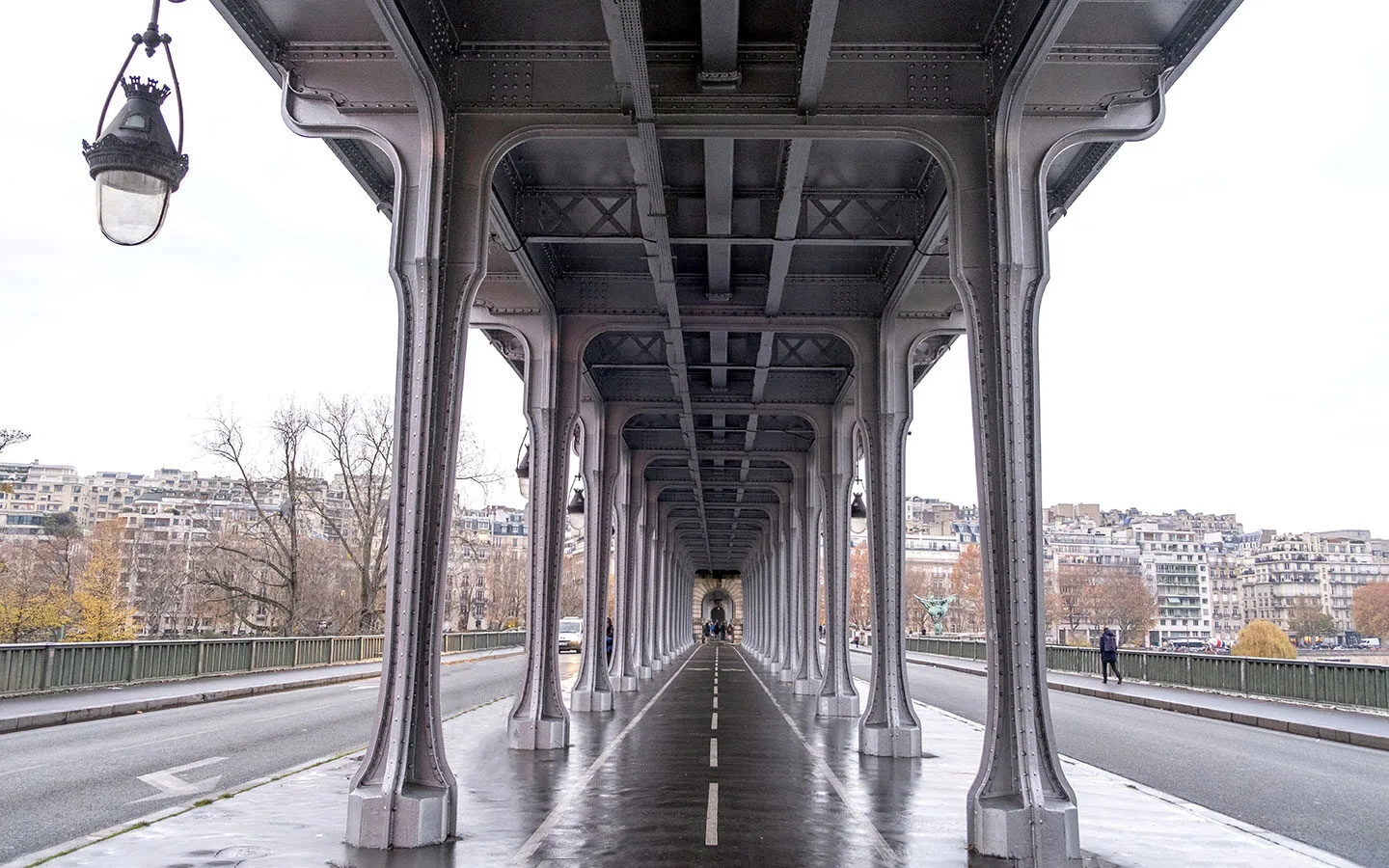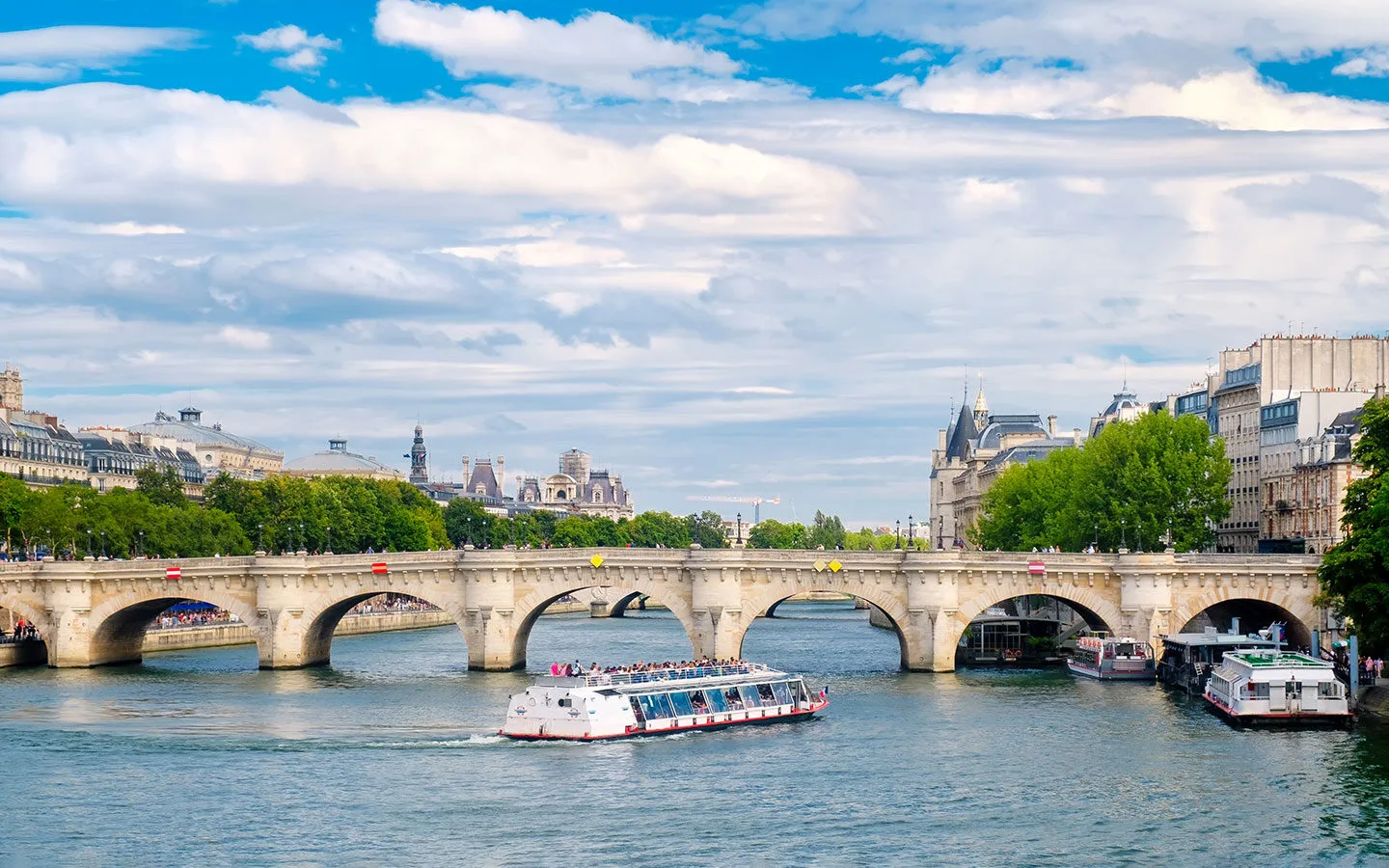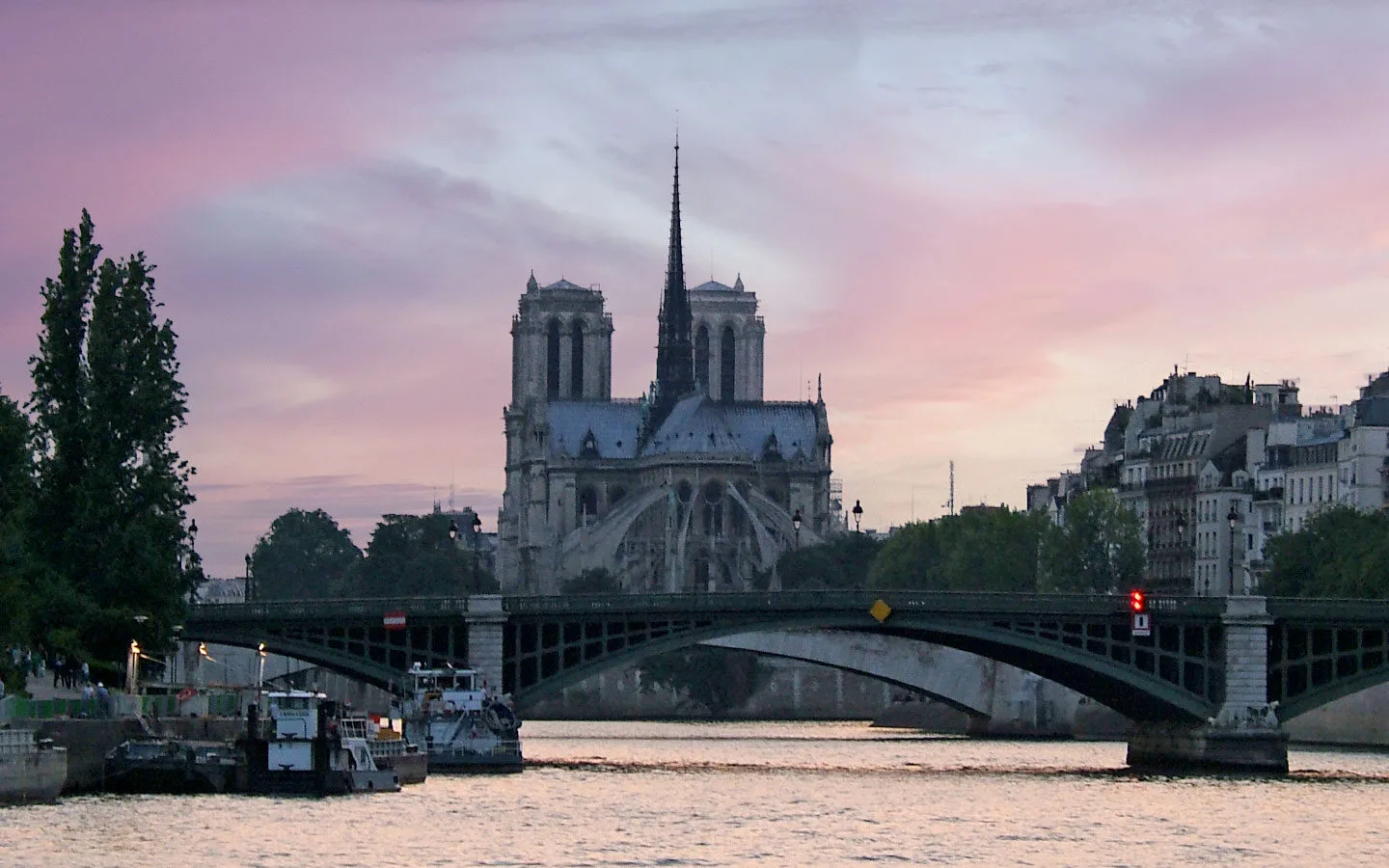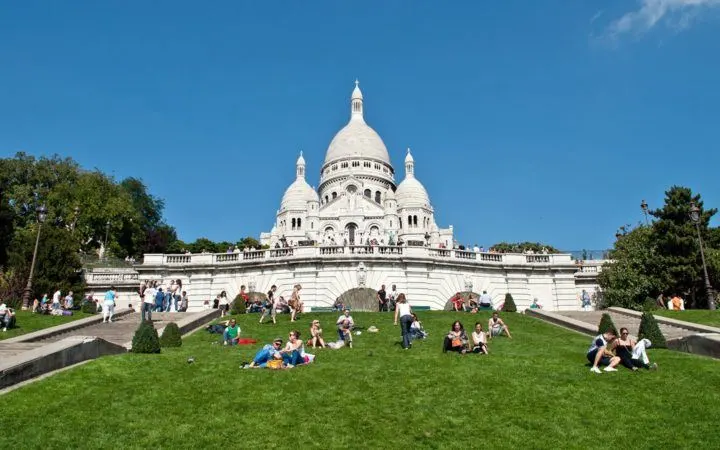Explore the streets of Paris through its film locations, from black and white classics to modern blockbusters, on this free self-guided Paris film locations walking tour – map and directions included.
* This site contains affiliate links, where I get a small commission from purchases at no extra cost to you.

In the words of the 2006 film anthology – Paris, Je T’aime. And as well as it being one of my favourite cities, Paris is also a favourite with film-makers. Its iconic buildings, pavement cafés, art galleries, bridges and gardens have featured in countless films and TV series, from Last Tango in Paris and Funny Face to The Da Vinci Code and Before Sunset.
This self-guided Paris film locations walking tour follows the Seine from the Eiffel Tower in the west to Notre Dame Cathedral in the east. Join us for a 7.6km (or 5km if you use the handy Métro short cut) journey across the city through the films it’s inspired.
A self-guided Paris film locations walking tour

Start your Paris film locations walking tour at the Pont de Bir-Hakeim, a bridge across the Seine which is just a couple of minutes’ walk from either Bir-Hakeim Métro station (Line 6) or the Champ de Mars Tour Eiffel RER station (Line C).
Pont de Bir-Hakeim
Originally known as the Pont de Passy when it was built in the early 1900s, the Pont de Bir-Hakeim was renamed after a Second World War battle in the Libyan desert. It’s built on two levels, with cars and pedestrians at the bottom and Métro trains on a viaduct above. And if you walk out to the middle you get a great view of the Eiffel Tower.
On screen the bridge appeared in the Christopher Nolan film Inception (2010). It’s conjured up by Ariadne (Ellen Page) when she’s learning to manipulate dreams, using mirrors to make it look like it’s stretching off into infinity. It’s also where Marlon Brando and Maria Schneider’s characters first meet in Last Tango in Paris (1972).

Staying on the Left Bank (the south side of the river), walk along Quai Jacques Chirac until you’re standing in front of the Eiffel Tower.
Eiffel Tower
The ultimate Parisian icon, the 330-metre-tall, wrought-iron Eiffel Tower* was built for the 1889 World’s Fair. Despite the locals not being all that impressed with it initially, the tower has become an integral part of the Parisian skyline. It’s also one of the city’s biggest tourist attractions, with over 300 million visitors since it first opened.
Pretty much every film or TV series set in Paris has a shot of the Eiffel Tower somewhere (how else would we know it was Paris?). But it got a starring role in 1985 James Bond film A View to a Kill, where Bond’s dining companion in the Jules Verne restaurant is killed with a poisoned butterfly by May Day (Grace Jones) before she jumps off the tower.
Fred Astaire, Kay Thompson and Audrey Hepburn sing and dance under the tower and on the viewing platform in the musical Funny Face (1957). Lois Lane hangs off the bottom of its lift in Superman II (1980). It’s also blown up by a cannon in The Great Race (1965) and miniatures of it are used to smuggle gold in The Lavender Hill Mob (1951).

The next hop is a bit bigger, so if you don’t want to walk all the way you can take the RER (Line C) from the Champ de Mars Tour Eiffel station to Invalides. Otherwise, carry on waking along Quai Jacques Chirac past the Musée du Quai Branly and Sewer Museum and on along the edge of the river until you reach Pont Alexandre III (1.6km).
Pont Alexandre III
The extravagant Alexandre III bridge was built in 1896 as a symbol of peace between France and Russia. It connects the Champs Elysées with the Invalides and is decorated in gloriously over-the-top style with four statues of giant golden flying horses as well as nymphs, cherubs and sea creatures, lit by ornate Art Nouveau lamps.
Anastasia, the possible surviving daughter of the Romanovs, was the granddaughter of Tsar Alexander III, and the bridge has been used in two films about and named after her – the 1956 Ingrid Bergman Oscar-winner and the 1997 animated movie.
After leaving the Eiffel Tower, Roger Moore’s James Bond leaps from the bridge into a passing boat in A View to a Kill. And it’s also seen in Luc Besson’s Angel-A (2005), Woody Allen’s Midnight in Paris (2011) and romantic drama Me Before You (2016).

Cross over the bridge so you’re on the Right Bank of the Seine, then turn right and follow the river for a few hundred metres to the Place de la Concorde.
Place de la Concorde
The Place de la Concorde is Paris’ largest square, stretching over almost 19 acres. During the French Revolution it was where Marie-Antoinette, Louis XVI and many others were publicly executed by guillotine. But after an 1830s redesign it’s now a big open space (albeit filled with crazy traffic) decorated with fountains and an Egyptian obelisk.
In The Devil Wears Prada (2006), the Fontaine des Fleuves (Fountain of the Rivers) in the Place de la Concorde is where Andy (Anne Hathaway) decides she’s not cut out for a job in the fashion industry after all and throws her mobile phone into the fountain.

From the Place de la Concorde, head through the gates into the Jardin des Tuileries.
Jardin des Tuileries
The Tuileries Palace and Gardens were built in the 16th century and take their name from the tile (tuile) factories there before. The palace was the French monarch’s residence until it was burnt down in 1871, and its formal gardens were later made into a public park.
In The Bourne Identity (2002), the Tuileries is where Marie gives Jason Bourne the phone records she’s stolen from the nearby Hotel Regina. Audrey Hepburn poses in the gardens with a bunch of balloons in Funny Face. And the Coen Brothers filmed a short film called Tuileries in the Métro station as part of the anthology Paris, Je T’aime (2006).

Exit the park on the north side onto Rue de Rivoli. Walk down Rue de Castiglione which leads to Place Vendôme, a smart square surrounded by designer shops which had a 1998 French crime film named after it, starring Catherine Deneuve.
Ritz Paris
At 15 Place Vendôme, the Ritz Paris* is one of the city’s most luxurious and expensive hotels, with a night in their Suite Imperiale costing a huge $20,000. Coco Chanel lived in the hotel for 34 years and other past guests include Ernest Hemingway, Edward VIII and the Princess of Wales, who died in a car accident after dinner at the hotel.
Art history must pay well for Professor Langdon (Tom Hanks), who stays in a suite at the Ritz at the end of The Da Vinci Code (2006). Kay Thompson danced with cab drivers outside the hotel in Funny Face, and her co-star Audrey Hepburn filmed sections of both Love in the Afternoon (1957) and How to Steal a Million (1966) there.

Backtrack to the top of Rue de Castiglione then turn left down Rue Saint Honoré and follow it for 900 metres to where it meets the Avenue de l’Opéra.
Café Le Nemours
With its elegant Roman columns, striped umbrellas and wicker chairs, the Café Le Nemours is your quintessential Parisian café. It’s tucked away behind the Louvre on Place Collette, close to the Palais Royal Gardens and in a prime spot for people-watching.
Enjoy a coffee on the terrace in the footsteps of Angelina Jolie, who shot the opening scenes for The Tourist (2010) here – her character had breakfast while being spied on by the French police. The café interiors also feature in 2011 French film Intouchables.

Cross Rue du Rivoli outside the café and go through Passage de Richelieu, which comes out in front of the Louvre pyramids.
The Louvre
As well as being one of the world’s biggest and best-known art museums, the Louvre* is a popular Paris film location. The main building, the Louvre Palace, was built in the late 12th century and became a museum after the French Revolution. Today there are over 35,000 works of art on display, including the Mona Lisa and Venus de Milo.
But are the remains of Mary Magdalene hidden under the inverted pyramid? That’s the theory in Dan Brown’s book The Da Vinci Code. Despite the big boost in visitors it gave them, the Louvre weren’t exactly keen on the book, but they gave permission for the 2006 movie to be filmed there – though they had to use a replica of the Mona Lisa.
Daniel Day-Lewis wanders around the galleries in The Age of Innocence (1993). Wonder Woman (2017)’s alter-ego is a curator in the Louvre’s Greek antiquities department. And it also makes an appearance in the upcoming John Wick: Chapter 4 (2023).

Walk through the archway to your left into the next courtyard of the Louvre, then head through another archway on the right which emerges onto the Quai François Mitterrand. Cross over the road onto the Pont des Arts bridge.
Pont des Arts
The Pont des Arts was Paris’ first metal bridge when it was built in 1802 – though the one you see today is an 1980s copy after the original was damaged. It’s a popular spot for artists to set up their easels, and is where the ‘love locks’ trend started, with couples attaching padlocks to the bridge’s railings then throwing the key into the Seine.
Two of the characters in Now You See Me (2013) add their locks to the bridge. But after a section of the railings collapsed from the weight of all the padlocks, the metal railings were replaced with glass panels to stop any more locks being added.
The Pont des Arts also also appears in the final episodes of the Sex and the City TV show (2004), and is where Mr Big tells Carrie he loves her after all. And Liam Neeson jumps off the bridge after his daughter’s kidnappers at the end of Taken (2008).

Walk across the bridge towards the imposing Institut de France. Then turn left and walk along the Quai du Conti to the next bridge – the Pont Neuf.
Pont Neuf
Despite its name, the ‘new bridge’ is actually Paris’ oldest bridge. It was built in 1578 for Henry III and has two different sections, connecting the Île de la Cité to the Left and Right Banks. In the middle there’s a triangle-shaped park that’s a popular spot to bring a picnic and a bottle of wine and sit watching the boats go by on a summer evening.
In Mrs Harris Goes to Paris (2022), Mrs Harris takes a stroll through the Jardins du Pont Neuf next to the bridge. It’s also where Jason Bourne sets up a clandestine meeting in The Bourne Identity. And it gives its name to the French film Les Amants du Pont Neuf (1990), a love story about two young homeless people who live on the bridge.

Continue walking along the Left Bank of the Seine to Quai de Montebello, where you’ll see Shakespeare and Company on your left.
Shakespeare and Company
The Shakespeare and Company bookstore is a Paris literary institution. It’s been selling new, second-hand and antique English-language books to Paris locals and visitors since 1951. Writers and artists can even stay there, with bunks tucked between the shelves where the ‘tumbleweeds’ sleep in return for helping out in the shop for a few hours a day.
The bookshop is where Jesse (Ethan Hawke) does a reading from his book in Before Sunset (2004). It also features in Midnight in Paris (2011) and Julie & Julia (2009). And while you’re there, look out for Le Caveau de la Huchette, a jazz bar just around the corner which appears in a dream sequence in the musical La La Land (2016).

Next continue walking along the riverside to the Quai de la Tournelle.
Quai de la Tournelle
The final location on this Paris film locations walking tour is the Quai de la Tournelle, an area on the waterfront where you get a great view back down the Seine towards Notre Dame Cathedral – currently undergoing repair after the major 2019 fire.
The quay is where Bourne and Marie spend their first night in Paris sleeping in a car in The Bourne Identity. It’s also another location from Before Sunset, where Jesse and Céline (Julie Delpy) decide to be tourists and take a boat trip* along the Seine.
From the Quai de la Tournelle, it’s a five-minute walk to Maubert Mutualité Métro station (Line 10). Or you can find a café or bar to finish off your walk with a drink – there’s a good selection of places just across the bridge on the Île Saint-Louis.

Paris film locations walking tour map
If you’d like to do this Paris film locations walk yourself, click on the map below to access directions through Google maps. The full route is 7.6km (4.7 miles) and takes 1 hour 40 minutes to walk straight through, but allow 2–3 hours including stops. Or the subway short cut between the Eiffel Tower and Pont Alexandre III cuts it down to 5km (3.1 miles).

Save for later






Johanna Bradley
Friday 23rd of December 2022
Sounds like the basis for a wonderful day, Lucy. Wishing you the merriest Christmas, and a healthy, happy new year.
Lucy Dodsworth
Wednesday 18th of January 2023
Thanks Jo, here's to a great 2023!